II Via Pompeia (Messina - Syracuse)
Phase B: Rev 1.0 (edited by Ignazio Caloggero)
Interactive map updated in real time. For a global view of all the historical itineraries of Sicily, for the presentation of the project, the "zoomable" historical maps taken as reference and the relative methodological notes, please refer to the project page: Ancient paths and historical itineraries of Sicily. For a view of all the routes in one web page, see: Ancient Paths and Historical Itineraries of Sicily: All the routes live.
The map shows the main "stations" and the archaeological sites encountered along the way. Under the map further details and technical notes.
Description
Summary of traits, sub-tracts and variants
- Section IIA (Messina – Naxos)
- Section IIB (Naxos – Acireale)
- Section IIC (Acireale – Catania)
- Section IID (Catania – Agnone)
- Section IIE (Agnone – Priolo)
- Variant IIE1 (Agnone – Augusta – Priolo)
- Variant IIE2 (Agnone – Villasmundo – Priolo)
- Section IIG (Priolo – Syracuse)
Below is the detailed description
Section IIA (Messina – Naxos)
- IIA-1: Messina (3.469 – 471) (CAMS) (C30) (C7) (C26) (C27)
- IIA-2: Pistunina village (CAMS) (C30) (C7) (C26) (C27)
- IIA-3: Ponte Schiavo (CAMS) (C30) (C7) (C26) (C27)
- IIA-4: Marina di Itala (CAMS) (C30) (C7) (C26) (C2) (C27)
- IIA-5: Sant'Alessio Siculo (C30) (C7) (C26) (C27)
- IIA-6: Taormina (3.469 – 471) (C30) (C26)
- IIA-7: Giardini Naxos (3.469 – 471) (C30) (C26) (C27)
- IIA-8: Cape Schisò (Naxos) (3.469 – 471) (CAMS) (C30) (C26)
Section IIB (Naxos – Acireale)
- IIB.1: Contrada Impero Ricca (CAMS) (C27) (C30) (C26)
- IIB.2: Contrada San Biagio (CAMS) (C30)
- IIB.3: Contrada Liberto (CAMS)
- IIB.4: Fiumefreddo (C30) (C26) (C27) (C4-C7) (C2)
- IIB.5: Mascali (C30) (C26) (C27) (C4-C7) (C2)
- IIB.6: Contrada Coste (Giarre) (CAMS)
- IIB.7: Trepunti (Three Bridges) (C30) (C26)
- IIB.8: San Leonardello (C30) (C4-17) (C26) (C2)
- IIB.9: Mangle (C30) (C4-C7) (C26) (C2)
- IIB.10: S. Maria degli Ammalati (C30) (C26)
- IIB.11: St. Cosmos (CAMS) (C30) (C26)
- IIB.12: Acireale (Acio) (3.469 – 471) (CAMS) (C30) (C27) (C26) (C2) (C12)
Section IIC (Acireale – Catania)
- IIC.1: Thermal Baths of Santa Venera (CAMS)
- IIC.2: Contrada Reitana (CAMS) (C27)
- IIC.3: Nizzetti (CAMS) (C26)
- IIC.4: Ficarazzi (C26)
- IIC.5: Great Fief (C26)
- IIC.6: Catania (Catina) (3.469 – 471)
Section IID (Catania – Agnone)
- IID.1: Porta Garibaldi (C26)
- IID.2: Cemetery (C26) (C30)
- IID.3: Via Zia Lisa/Via Fenice (C26) (C30)
- IID.4: Primosole (mouth of the Simeto) (3.469 – 471) (C30) (C2) (C4-C7)
- IID.5: Agnone – Murgo (CAMS) (C30) (C2) (C2) (C4-C7)
- Section IIE (Agnone – Priolo)
Variant IIE1 (Agnone – Augusta – Priolo)
- IIE.1.1: San Calogero – Maldicente (CAMS) (C26) (C30)
- IIE.1.2: Cozzo Telegraph – Vallone Maccaudo (CAMS) (C30) (C26)
- IIE.1.3: Arcile (CAMS) (C30) (C26)
- IIE.1.4: Perceptor (CAMS) (C30) (C26)
- IIE.1.5: Ippolito plan (C30) (C26)
- IIE.1.6: Augsburg (CAMS) (C30) (C26)
- IIE.1.7: Costa dei Conti (CAMS) (C30) (C26)
- IIE.1.8: Valle del Mulinello (CAMS) (C30) (C26)
- IIE.1.9: Contrada Panarazzo – Marcellino (CAMS) (C30) (C26) (C2)
- IIE.1.10: Royal Bridge (Marcellino River) (C30) (C26)
- IIE.1.11: Carved – Samperi CAMS) (C30) (C26)
- IIE.1.12: Contrada Nicollizia (C30) (C26)
- IIE.1.13: San Cusumano (4-471 : Cosimano – C26: Cusimano ) (C27)
- IIE.1.14: Riuzzo CAMS)
- Priolo
Variant IIE2 (Agnone – Villasmundo – Priolo)
- IIE.2.1: Jester (CAMS) (C30) (C26)
- IIE.2.2: Orto Gallo (CAMS) (C30) (C26)
- IIE.2.3: Piscitello (CAMS) (C30)
- IIE.2.4: Caracausi (CAMS) C30) (C26)
- IIE.2.5: Lentini (3.469 ) (CAMS) (C30) (C26) (C5) (C20) (C27) (C4-C7)
- IIE.2.6: Contrada S. Eligio – S. Mauro – Contrada Crocifisso (CAMS)
- IIE.2.7: Carlentini (3.469) (CAMS) (C5) (C26) (C27) (C4-C7)
- IIE.2.8: Porrazzito (CAMS) (C26) (C30)
- IIE.2.9: Villasmundo (CAMS) (3.469 – 471) (C26) (C27) (C4-C7) (C30)
- IIE.2.10: Contrada Fossa and Pantalone (CAMS) (C26) (C30)
- IIE.2.11: Bernardine (CAMS) (C26) (C30)
- IIE.2.12: Contrada Bondifè (CAMS) (C26) (C30)
- Priolo
Section IIG (Priolo – Syracuse)
- IIG.2.1: Contrada Torre del Fico (C27) (C26) (CAMS) (C30)
- IIG.2.2: Spire of Marcellus (CAMS) (C30) (C26)
- IIG.2.3: Fondaco Nuovo (CAMS) (C26) (C30)
- IIG.2.4: Vallone Mandre (CAMS) (C26) (C30)
- Syracuse (3.469 - 471) (CAMS) (C26) (C30) (one entered the ancient walls at the Scala Greca)
Insights
Section IIA (Messina – Naxos)
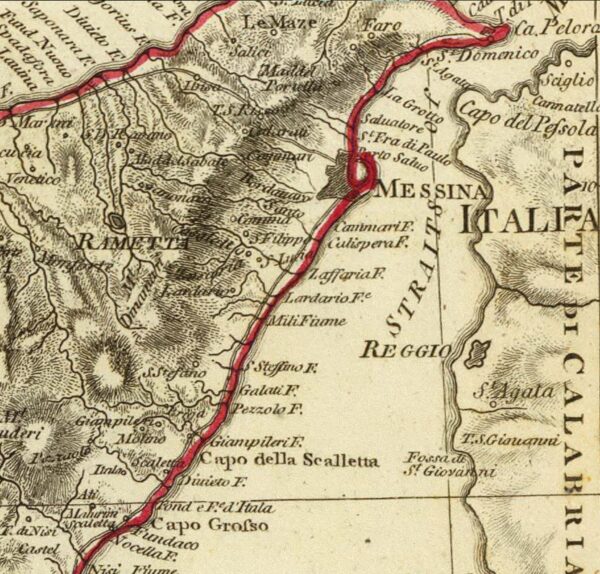 C7: detail
C7: detail
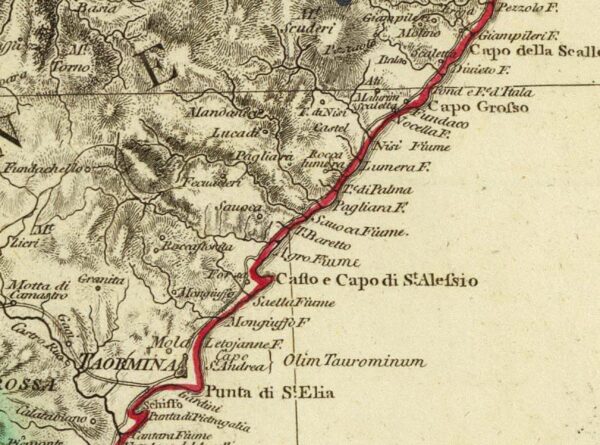 C7: detail
C7: detail
Section IIB (Naxos – Acireale)
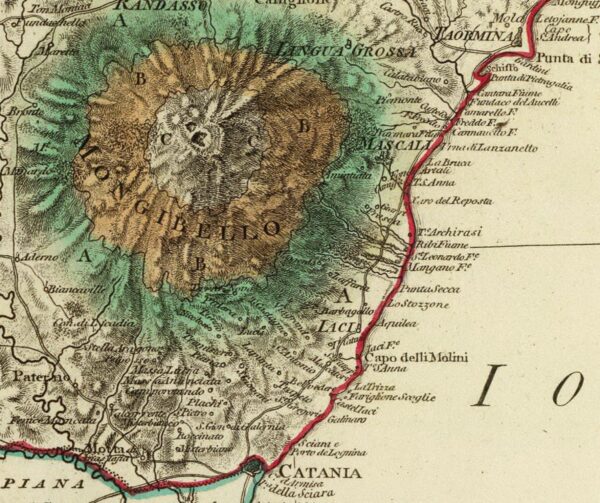
C7: detail
Section IIC (Acireale – Catania)
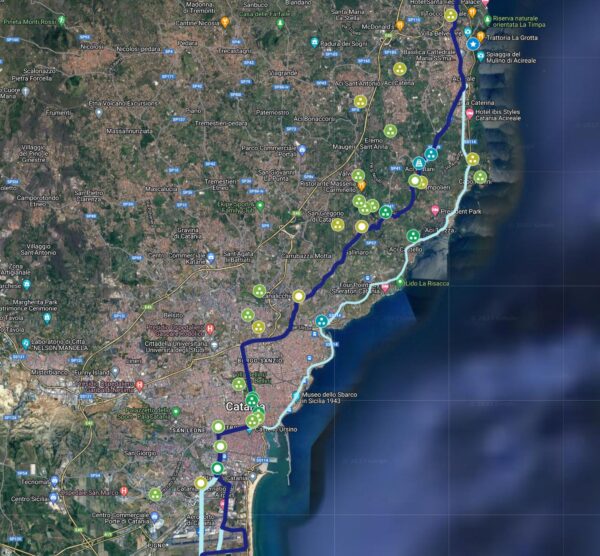
The hypothesis of deepening the stretch in light blue as a possible alternative should be evaluated
Section IID (Catania – Agnone)
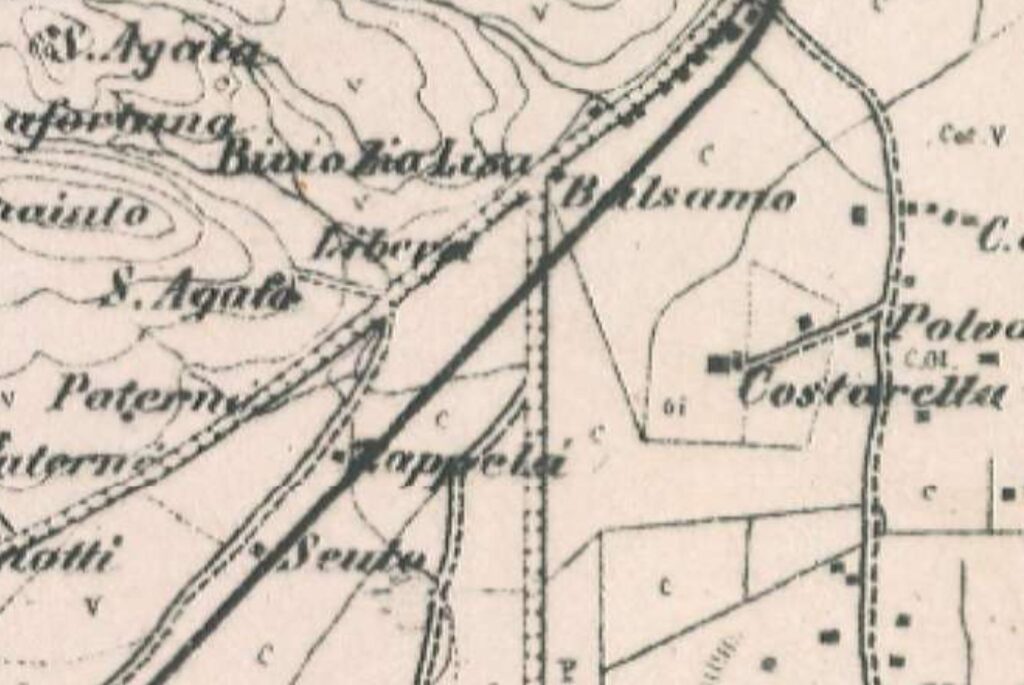
C26: Crossroads Aunt Lisa
Section IIE (Agnone – Priolo)

C2: Detail

C26 Royal Bridge (Marcellino River)

C27 s. Cosimano
Variant IIE1 (Agnone – Augusta – Priolo)
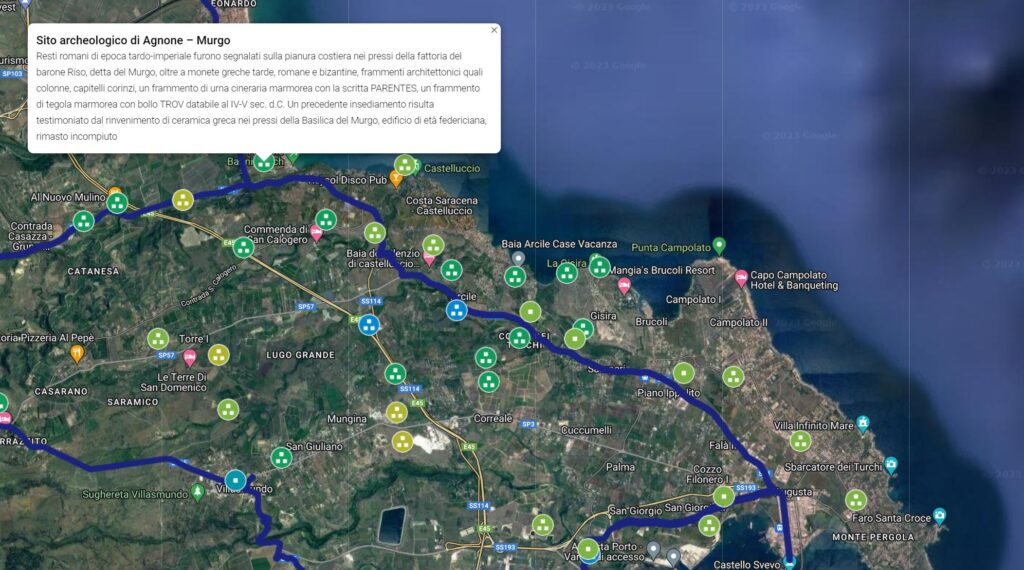
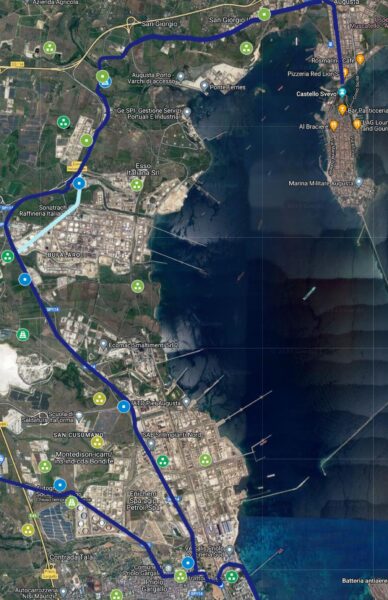
Variant IIE2 (Agnone – Villasmundo – Priolo)
Section IIG (Priolo – Syracuse)
To identify the details associated with the cartography and bibliography used, represented here by numbers and letters, go to the page: Methodological Notes and Bibliography
Bibliography and Reference Cartography.
(1) (3) (13) (15) (17) (22) (36) (40) (42) (60) (99) (CAMS) (C2) (C4) (C7) (C12) (C13 ) (C14) (C15A) (C16) (C17) (C18) (C20) (C26) (C27) (C29) (C30)
- [1] Giovanni Uggeri: The formation of the Roman road system in Sicily
- [3] Biagio Pace: Art and Civilization of Ancient Sicily Vol. 1 pag. 453-488
- [13]: G. Uggeri: Itineraries and roads, routes, ports and ports of call of late ancient Sicilyin Proceedings IX Ancient Sicily Congress (Palermo 1997), "Kokalos" 43-44 (1997-1998), Rome 2000, pp. 299-364.
- [15]: G. Uggeri: The Roman road system in Sicily with particular regard to the third and fourth centuries. In Kokalos XXVIII-XXIX 1982-1983
- [17]: G. Uggeri: Sicily in the "Tabula Peutingeriana" - Editore Loffredo - Naples 1968
- [22] Adolfo Holm History of Sicily Antiquity Vol. III Chap IV
- [36] Tommaso Fazello - History of Sicily Volume I. Palermo
- [40] Thucydides - The Peloponnesian War Vol. VI, VII
- [42] Giorgio Bejor - Aspects of the Romanisation of Sicily. In: Modes de contacts et processus de transformation dans les sociétés anciennes. Actes du colloque de Cortone (May 24-30, 1981) Rome: École Française de Rome, 1983. pp. 345-378. (Publications de l'École française de Rome, 67);
- [60] Luigi Santagati: A little light on the Roman Via Valeria. In "Historical and archaeological research in Val Demone - Proceedings of the II conference Barcellona Pozzo di Gotto (ME) Jalari Park - 1 and 2 April 2017"
- [99] Ignazio Caloggero: The Project Ancient Paths and Historical Itineraries of Sicily
- CAMS: Multimedia Archaeological Map of Sicily - Link: https://www.lasiciliainrete.it/archivio-patrimonio-archeologico-di-sicilia/
- C2: Regni & Insvlae Siciliae Tabula geographica ex Archetypo gradiori in hoc compendium redacta - 1747 author: Homann, Johann Baptist
- C4: Nova et accurate Siciliae Regionum, Urbium, Castellorum, Pagorum Montium, Sylvarum, Planitierum, Viarum Situum ac Singularium quorumque locorum et rerum ad Geographiam Partinentium Descriptio Universalis - 1721 author Schmettau, Samuel von
- C7: Sicily. Publisher: Robert Laurie & James Whittle (1799) (always referable to the Schmettau paper)
- C12: Siciliae Antiquae quae et Sicania et Trinacria dicta tabula geographic. Publisher: L'Isle, Guillaume de, 1675-1726
- C13: [4] Tabula Peutingeriana (medieval map of the Roman world written by a monk of Colmar XIII century
- C14: [5] Itinerarium Antonini
- C15A: General Map of the Island of Sicily - Officio Topografico 1826 (South-East)
- C16: Guidelines of the Regional Territorial Landscape Plan - Historic road network
- C17: Syracuse at the time of Gelone and Gelone I map with the roads leaving Syracuse attached to the book by Adolfo Holm: Storia di Sicilia-Vol. THE
- C18: Sicily Trazzerale Network (1929). Published in the Journal of the Land Registry and Tax Services in 1941
- C20: The island of Sicily divided into its valleys. Chamber chalcography (1792) (Rome, Italy) - Author: Ram, de Johannes 1648-1693
- C26: Europe in the XNUMXth century. century (with the Third Military Survey)
- C27: Comparative Map of Modern Sicily (1859)
- C28: Siciliae Antiquae Tabula (1834) (Sicily Tabulae Peutingerianae)
- C29: La Sicile Pour l'Histoire Romaine (1740)
- C30: Cartography of the Landscape Plans of the Sicily Region which can be consulted online (for the trazzere and historical routes)
For the bibliography and general cartography see the page: Methodological Notes and Bibliography
Technical and methodological note
The Multimedia Map of the Ancient Historical Routes is created in two sub-phases (not necessarily sequential):
- Phase A (Basic Path): in the first sub-phase the paths are identified in the form of a first draft divided into segments and sections (taking into account the bibliography, the historical maps analyzed and the Multimedia Archaeological Map of Sicily (CAMS) and only partially the paths on the ground). The basic route is the starting point proposed to the scientific community, preparatory to the subsequent phase of detailed analysis of the individual segments that make up the entire identified path
- Phase B (Advanced Path): in the second phase, an incremental refinement process will begin by adapting, as faithfully as possible, the individual components that make up the route to the historical routes and to the tracks on the ground and where the ancient traces have been lost, adapt them to the current routes that are closest to the ancient paths (keeping track of the historical paths, where identified). The incremental refinement process will also take into account historical roads, natural roads and further studies and contributions from the scientific community and scholars in the sector.
- Phase C (Subdivision of the paths): When fully operational, the project provides for the drafting of two paths that may diverge in some points: a path as faithful as possible to the ancient path regardless of its current practicability and another that could form the basis for proposing itineraries that take into account the actual practicability and the possibility of enjoying the historical, artistic and naturalistic beauties close to the historical route.
Note: In cases where the ancient route is no longer identifiable or has been completely replaced by high-speed roads, or obstructed by industrial plants or other types of impediment, an attempt has been made to identify a stretch that in some way is closest to the characteristics of a naturalistic path or in any case a substitute for the fast-flowing path. In some cases, moreover, in case of doubt between two possible routes, the route that allows you to pass in the immediate vicinity of landscapes or cultural heritage considered interesting from a tourist-cultural point of view has been taken into consideration.


